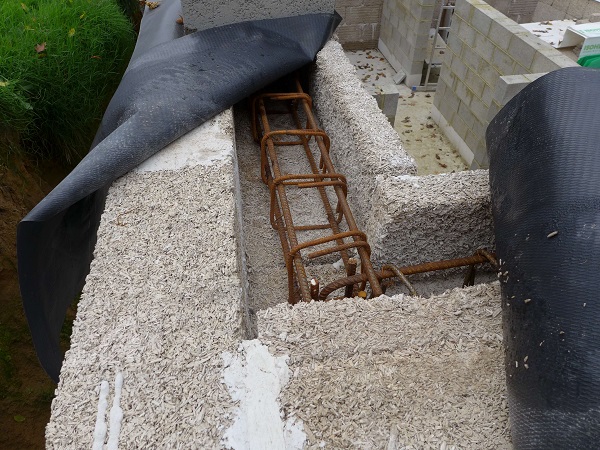Building materials, textiles, and plastics, in this 3-part series, we’ll explore some of the ways hemp is set to change the world.
Concrete, steel, and wood pale in comparison as a sustainable building material to the plant known to grow like a weed — hemp.
With construction consuming a whopping 40% of the world’s global energy and resources, it is imperative that this industry moves towards more sustainable practices in the face of climate change’s many threats. This means moving away from building materials which are mined from the earth or harvested from rapidly depleting forests, and making the switch to renewable resources — and hemp is the perfect material for the job, in the form of a mixture known as hempcrete.
What is Hempcrete?
Hempcrete is a building composite similar to concrete, except it’s made by wet-mixing hemp hurds (woody fibers from the plant core) with a lime-based binder and water. This mixture can then be cast into molds or applied directly as a wet loose-fill material which hardens once dried, serving several construction and insulation purposes.
For instance, hempcrete may come in modular block form — similar to concrete masonry units — for building structures. It may also be used to form insulated walls, with the only other material being the wooden structural frame.
Moreover, hempcrete can be used in combination with other building materials to form both floors and roofs, providing an insulating layer. Astonishingly, hempcrete can even be used today for load-bearing walls. UK Hempcrete has a new system consisting of adapted hempcrete blocks and reinforced concrete.
Photo credit to UK Hempcrete
Hempcrete is also an ideal building material to be used to restore or retrofit traditional or historic buildings. For example, hempcrete can replace or repair infill panels in timber frame buildings, be used to add insulation to solid walls in older buildings with poor insulation, or it can be applied to unevenly shaped walls to improve their appearance.
Hempcrete provides a wide range of benefits — commercially, structurally, and environmentally.
Benefits of Using Hempcrete
Hempcrete has numerous advantages as a building material. Hempcrete lacks the brittleness of regular concrete, removing the need for expansion joints typically required for absorbing vibration and temperature-induced expansion and contraction in structures. Easier to work with, hempcrete is also much more lightweight.
Unlike wood, hempcrete is naturally fire-resistant and pest-resistant. For example, it is virtually impossible for a hempcrete building to become infested with termites.
The material is also highly useful for structures in earthquake-prone areas, as hempcrete’s low density renders it resistant to cracking under movement.
Walls made from hempcrete are very breathable and allow moisture to pass through, which makes hempcrete highly resistant to mold. Moreover, it has low thermal conductivity and wind-resistant properties, making hempcrete an ideal insulator. Buildings made from hempcrete easily stay cool in the summer and warm in the winter — resulting in a perfect material for nearly any climate and leading to substantial energy savings.
“In many climates, a 12-foot hempcrete wall will facilitate approximately 60-degrees indoor temperatures year-around without heating or cooling systems,” said Joyce Beckerman, vice president of the Hemp Industries Association, in an interview. “The overall environmental footprint is dramatically lower than traditional construction.”
Environmentally, hempcrete can’t be beaten as an eco-friendly building material. Hempcrete is carbon negative, as the crop sucks up CO2 as it grows. Hemp can be produced very quickly without the need for pesticides or fertilizer, making it rapidly renewable. For those aiming to achieve a low carbon footprint, building with hempcrete is an optimal choice.
Drawbacks to Hempcrete
While the benefits to using hempcrete are numerous, there are some hurdles this material has to overcome — namely, the cannabis plant still has a negative stigma surrounding it and it is highly regulated or downright illegal to grow in many countries.
This recently changed in the United States, however, with the passing of the Hemp Farming Act of 2018, part of the 2018 Farm Bill. Thanks to this bill, hemp has been legalized federally, changing from a controlled substance to an agricultural commodity.
Despite this massive progress, American hemp businesses still face challenges in traditional marketing and sales approaches, as many online advertising platforms and financial institutions still do not distinguish between hemp and marijuana — thus banning all hemp-related companies from advertising on their platforms.
Where is Hempcrete Being Used Today?
Hemp-based structures date back to Roman times, though the first modern-day hempcrete building was constructed in 1986 in France. Today, hemp-based structures can be found all over the globe.
As hemp cultivation is legal across Europe, the continent has hundreds of buildings utilizing hempcrete. France, in particular, leads the way, as they are the largest hemp producer in Europe.
In the US, there are currently over 50 homes made from hempcrete, the first being built in North Carolina in 2010. Hempitecture, a Washington-based company, has been retrofitting homes using the material. In Colorado, there is Left Hand Hemp, located in Denver, who builds hemp structures and helps teach others through seminars about hempcrete. We can expect to see a lot more buildings utilizing hempcrete in the coming years in the US, now that hemp has been legalized federally.
Other countries catching onto the hempcrete trend include Israel, Nepal, Australia, New Zealand, Canada, and the UK.
It’s likely many more countries will begin to follow suit in Europe’s and the US’s footsteps of allowing cultivation of hemp soon. As hemp’s negative stigmas continue to be eradicated and its numerous benefits come to light, the use of hempcrete could skyrocket around the world. Seeing that it is incredibly sustainable and cost-effective, this trend will continue to benefit businesses, families, and our planet itself.
The post The Amazing World of Hemp: Hempcrete – the Most Sustainable Building Material on Earth appeared first on CBD For Life.

